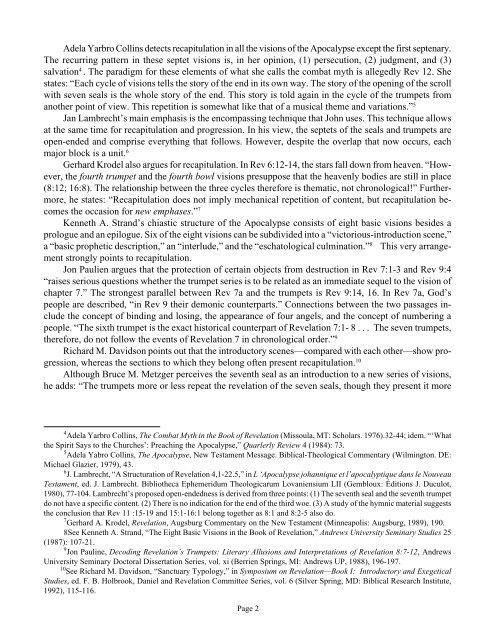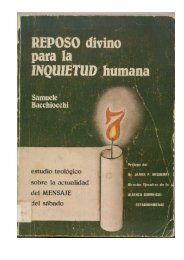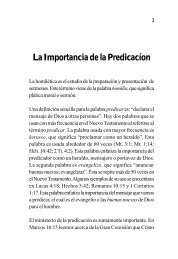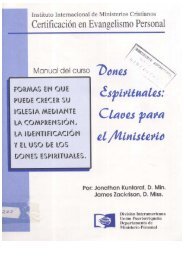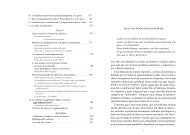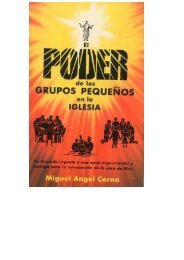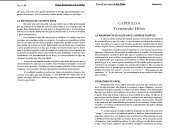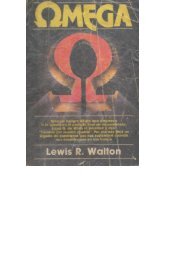Adela Yarbro Coll<strong>in</strong>s detects recapitulation <strong>in</strong> all the visions of the Apocalypse except the first septenary.The recurr<strong>in</strong>g pattern <strong>in</strong> these septet visions is, <strong>in</strong> her op<strong>in</strong>ion, (1) persecution, (2) judgment, and (3)salvation 4 . The paradigm for these elements of what she calls the combat myth is allegedly Rev 12. Shestates: “Each cycle of visions tells the story of the end <strong>in</strong> its own way. The story of the open<strong>in</strong>g of the scrollwith seven seals is the whole story of the end. This story is told aga<strong>in</strong> <strong>in</strong> the cycle of the trumpets fromanother po<strong>in</strong>t of view. This repetition is somewhat like that of a musical theme and variations.” 5Jan Lambrecht’s ma<strong>in</strong> emphasis is the encompass<strong>in</strong>g technique that John uses. This technique allowsat the same time for recapitulation and progression. In his view, the septets of the seals and trumpets areopen-ended and comprise everyth<strong>in</strong>g that follows. However, despite the overlap that now occurs, eachmajor block is a unit. 6Gerhard Krodel also argues for recapitulation. In Rev 6:12-14, the stars fall down from heaven. “However,the fourth trumpet and the fourth bowl visions presuppose that the heavenly bodies are still <strong>in</strong> place(8:12; 16:8). The relationship between the three cycles therefore is thematic, not chronological!” Furthermore,he states: “<strong>Recapitulation</strong> does not imply mechanical repetition of content, but recapitulation becomesthe occasion for new emphases.” 7Kenneth A. Strand’s chiastic structure of the Apocalypse consists of eight basic visions besides aprologue and an epilogue. Six of the eight visions can be subdivided <strong>in</strong>to a “victorious-<strong>in</strong>troduction scene,”a “basic prophetic description,” an “<strong>in</strong>terlude,” and the “eschatological culm<strong>in</strong>ation.” 8 This very arrangementstrongly po<strong>in</strong>ts to recapitulation.Jon Paulien argues that the protection of certa<strong>in</strong> objects from destruction <strong>in</strong> Rev 7:1-3 and Rev 9:4“raises serious questions whether the trumpet series is to be related as an immediate sequel to the vision ofchapter 7.” The strongest parallel between Rev 7a and the trumpets is Rev 9:14, 16. In Rev 7a, God’speople are described, “<strong>in</strong> Rev 9 their demonic counterparts.” Connections between the two passages <strong>in</strong>cludethe concept of b<strong>in</strong>d<strong>in</strong>g and los<strong>in</strong>g, the appearance of four angels, and the concept of number<strong>in</strong>g apeople. “The sixth trumpet is the exact historical counterpart of <strong>Revelation</strong> 7:1- 8 . . . The seven trumpets,therefore, do not follow the events of <strong>Revelation</strong> 7 <strong>in</strong> chronological order.” 9Richard M. Davidson po<strong>in</strong>ts out that the <strong>in</strong>troductory scenes—compared with each other—show progression,whereas the sections to which they belong often present recapitulation. 10Although Bruce M. Metzger perceives the seventh seal as an <strong>in</strong>troduction to a new series of visions,he adds: “The trumpets more or less repeat the revelation of the seven seals, though they present it more4 Adela Yarbro Coll<strong>in</strong>s, The Combat Myth <strong>in</strong> the Book of <strong>Revelation</strong> (Missoula, MT: Scholars. 1976).32-44; idem. “‘Whatthe Spirit Says to the Churches’: Preach<strong>in</strong>g the Apocalypse,” Quarlerly Review 4 (1984): 73.5 Adela Yabro Coll<strong>in</strong>s, The Apocalypse, New Testament Message. Biblical-Theological Commentary (Wilm<strong>in</strong>gton. DE:Michael Glazier, 1979), 43.6 J. Lambrecht, “A Structuration of <strong>Revelation</strong> 4,1-22.5,” <strong>in</strong> L ‘Apocalypse johannique et l’apocalyptique dans le NouveauTestament, ed. J. Lambrecht. Bibliotheca Ephemeridum Theologicarum Lovaniensium LII (Gembloux: Éditions J. Duculot,1980), 77-104. Lambrecht’s proposed open-endedness is derived from three po<strong>in</strong>ts: (1) The seventh seal and the seventh trumpetdo not have a specific content. (2) There is no <strong>in</strong>dication for the end of the third woe. (3) A study of the hymnic material suggeststhe conclusion that Rev <strong>11</strong> :15-19 and 15:1-16:1 belong together as 8:1 and 8:2-5 also do.7 Gerhard A. Krodel, <strong>Revelation</strong>, Augsburg Commentary on the New Testament (M<strong>in</strong>neapolis: Augsburg, 1989), 190.8See Kenneth A. Strand, “The Eight Basic Visions <strong>in</strong> the Book of <strong>Revelation</strong>,” Andrews University Sem<strong>in</strong>ary Studies 25(1987): 107-21.9 Jon Paul<strong>in</strong>e, Decod<strong>in</strong>g <strong>Revelation</strong>’s Trumpets: Literary Allusions and Interpretations of <strong>Revelation</strong> 8:7-12, AndrewsUniversity Sem<strong>in</strong>ary Doctoral Dissertation Series, vol. xi (Berrien Spr<strong>in</strong>gs, MI: Andrews UP, 1988), 196-197.10 See Richard M. Davidson, “Sanctuary Typology,” <strong>in</strong> Symposium on <strong>Revelation</strong>—Book I: Introductory and ExegeticalStudies, ed. F. B. Holbrook, Daniel and <strong>Revelation</strong> Committee Series, vol. 6 (Silver Spr<strong>in</strong>g, MD: Biblical Research Institute,1992), <strong>11</strong>5-<strong>11</strong>6.Page 2
from God’s standpo<strong>in</strong>t. . . Follow<strong>in</strong>g this complicated and repetitious pattern, John preserves unity <strong>in</strong> hiswork, <strong>in</strong>terlock<strong>in</strong>g the various parts together and at the same time develop<strong>in</strong>g his themes. The development,however, is not <strong>in</strong> a strictly logical fashion, such as we are familiar with <strong>in</strong> Western writ<strong>in</strong>g; it is,rather, a product of the Semitic m<strong>in</strong>d, which runs through the whole picture aga<strong>in</strong> and aga<strong>in</strong>. Thus, theseven seals and the seven trumpets essentially tell the same th<strong>in</strong>g, each time emphasiz<strong>in</strong>g one or anotheraspect of the whole.” <strong>11</strong>This brief review <strong>in</strong>dicates that the idea of recapitulation <strong>in</strong> <strong>Revelation</strong> is not uncommon amongmodern scholarship. However, the biblical text has to be studied on its own. This is the step we have to turnto.IV. <strong>Recapitulation</strong> and the Delimitation of PassagesMost scholars would agree that Rev 1 consists of an <strong>in</strong>troduction to the entire Book of <strong>Revelation</strong>(1:1-8) and a vision that should be regarded as an <strong>in</strong>troduction to the seven letters (1:9-20). 12 This meansthat the first septet has an <strong>in</strong>troductory scene, a device one will also f<strong>in</strong>d with the other major parts of<strong>Revelation</strong>. There is also a clear-cut end of this first septet at Rev 3:22 and the beg<strong>in</strong>n<strong>in</strong>g of a new sectionwith Rev 4:1, although 3:21 already prepares the way for the next section of <strong>Revelation</strong>. 13The question where the seven seals end and where a new block beg<strong>in</strong>s, however, is of vital importance,for it has to do with the very issue of recapitulation, and it decisively affects the <strong>in</strong>terpretation of<strong>Revelation</strong>, as we have already po<strong>in</strong>ted out above.Several scholars suggest that the seven seals comprise the rest of the book. Out of the seventh seal theother judgment series come forth, at least the seven trumpets. 14 This view is largely dependent on the<strong>11</strong> Bruce M. Metzger, Break<strong>in</strong>g the Code: Understand<strong>in</strong>g the Book of <strong>Revelation</strong> (Nashville: Ab<strong>in</strong>gdon, 1993), 55-56.12 For example, Eugenio Cors<strong>in</strong>i, The Apocalypse: the Perennial <strong>Revelation</strong> of Jesus Christ, Good News Studies, vol. 5(Wilm<strong>in</strong>gton, DE: Michael Glazier, 1983), 62,65; Elisabeth Schüssler Fiorenza, “Composition and Structure of the Book of<strong>Revelation</strong>,” The Catholic Biblical Quarterly 39 (1977): 364; Mart<strong>in</strong> Karrer, Die Johannesoffenbarung als Brief: Studien zuihrem literarischen. historischen und theologischen Ort, Forschung zur Religion und Literatur des Alten und Neuen Testaments,vol. 140 (Gött<strong>in</strong>gen: Vandenhoeck & Ruprecht, 1986), 217-219. Kenneth A. Strand, Interpret<strong>in</strong>g the Book of <strong>Revelation</strong>:Hermeneutical Guidel<strong>in</strong>es, with Brief Introduction to Literary Analysis, rev. and enl. ed. (Worth<strong>in</strong>gton, OH: Ann Arbor, 1976),51, perceives the vision of chap. 1 and the seven churches as one unit, but he starts only with 1:<strong>11</strong>.13 See the terms “throne” and “overcomer.” Indicators for a new part of <strong>Revelation</strong> start<strong>in</strong>g with 4: 1 are the follow<strong>in</strong>g: (1)Rev 4 beg<strong>in</strong>s with the formula “after this I saw, and behold” (meta tauta eidon, kai idou.) John sees an open door <strong>in</strong> heaven andis <strong>in</strong>vited to come up there to learn what will happen “after this” (meta tauta) (4:1). The Book of <strong>Revelation</strong> conta<strong>in</strong>s severalstructur<strong>in</strong>g formulas. Work<strong>in</strong>g through the entire document, one gets the impression that no formula besides “and I saw” (kaieidon) and those derived from it “and I saw, an behold, after this I saw; after this I saw, and behold; and I saw, and I heard” (kaieidon, kai idou; meta touto eidov; meta tauta eidon, kai idou; kai eidon, kai ‘kousa) have the same structur<strong>in</strong>g force. “I saw”(eidon) without the conjunction “and” (kai) or without the prepositional phrase “after this/I saw” (meta touto/meta tauta) neveroccurs at the beg<strong>in</strong>n<strong>in</strong>g of a sentence, as the structur<strong>in</strong>g formulas do, and has little or no force as a structur<strong>in</strong>g element. Theformulas “and behold” (kai idou) and “and” (kai) “I heard” (kai ‘kousa) seem to have some value for structur<strong>in</strong>g passages. Theyare, however, much weaker than is “and I saw” (kai eidon) and often seem to be dependent on it. Forms of the verb “to see”(eidon) occur <strong>in</strong> Rev 1, but not at all <strong>in</strong> Rev 2-3. Yet, even <strong>in</strong> Rev 1, “and I saw”(kai eidon) and derived forms are not found. Thefirst clear structur<strong>in</strong>g formula comes <strong>in</strong> Rev 4:1. This is a strong <strong>in</strong>dication that a new section starts with 4:1. (2) In the firstchapters of the Apocalypse, a movement from earth to heaven takes place. Rev 1-3 seems to play on earth. In Rev 4, John <strong>in</strong> thespirit sees heavenly realities, an entire new sett<strong>in</strong>g. (3) There is also a change <strong>in</strong> personages. The churches of Rev 2-3 fade away,and a throne with the one sitt<strong>in</strong>g on it, twenty-four elders, and four be<strong>in</strong>gs appear. In Rev 5, angels and a lamb are added. (4) Rev4-5 functions as an <strong>in</strong>troduction to the next septet <strong>in</strong> the same way that Rev 1:9-20 <strong>in</strong>troduces the first. (5) Compared with thefirst septet, there is a change of style with the second one. The former uses the style of a letter; <strong>in</strong> the latter, narrative and hymnsoccur.14 See, for example, Gary G. Cohen, Understand<strong>in</strong>g <strong>Revelation</strong>: An Investigation of the Key Interpretational andChronological Questions Which Surround the Book of <strong>Revelation</strong> (Chicago: Moody, 1978), 96; Hans Werner Günther, DerNah- und Enderwartungshorizont <strong>in</strong> der Apokalypse des heiligen Johannes, Forschung zur Bibel (Würzburg: Echter Verlag,Page 3


